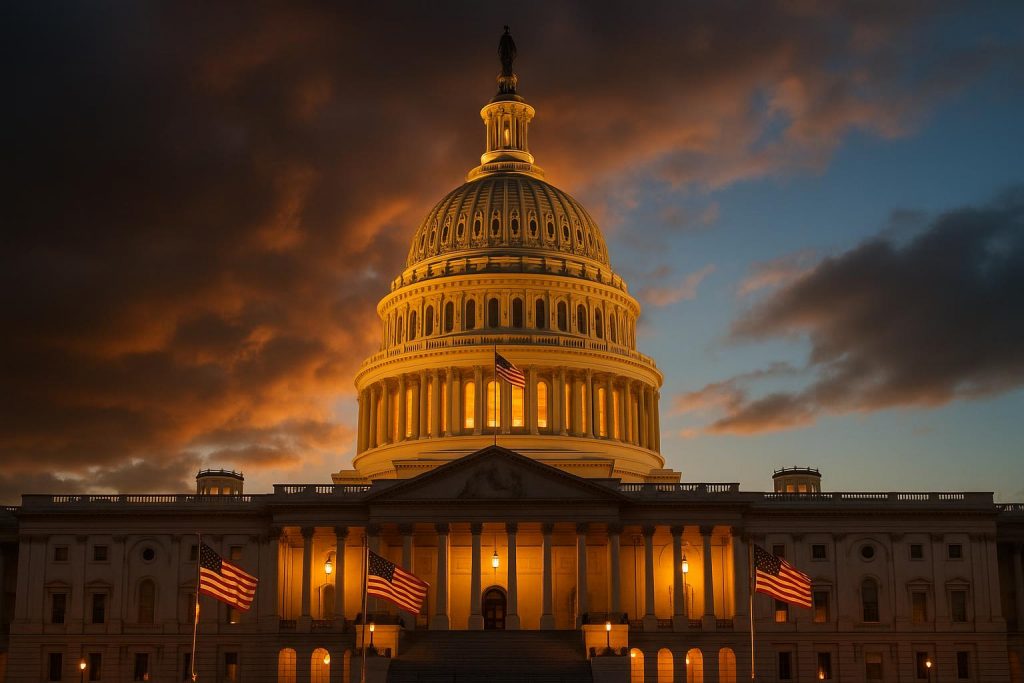Shutdown Ends, Crypto Crackdown Begins: A Deep Dive into US Regulation & Enforcement

November 2025 will be remembered as the month financial paralysis gave way to regulatory acceleration. After a debilitating 43-day government shutdown—the longest in U.S. history—Washington is back online. The temporary resolution has unlocked a flurry of legislative and enforcement activity, with the digital assets sector squarely in the spotlight.
Welcome to Washington’s unofficial “Crypto Week.” Lawmakers are advancing critical market structure bills while the Department of Justice (DOJ) cracks down on illicit finance. This dual-track approach signals a new era for crypto in the United States: one defined by clear rules and serious consequences.
This report dissects these converging timelines, from the end of the political impasse to the new regulatory frameworks and their impact on the market. Here’s what businesses and investors need to know as the future of digital finance is forged in real-time.
1. The 43-Day Impasse: Anatomy of a Historic Shutdown
The conclusion of the 43-day federal government shutdown on November 14, 2025, ended a period of profound economic anxiety. Surpassing the previous 35-day record, this shutdown paralyzed federal operations, furloughed hundreds of thousands of workers, and created a dangerous data blackout for the Federal Reserve.
The Legislative Breakthrough
The resolution came from a bipartisan compromise after intense pressure fractured political blocs. A coalition of moderate Democrats and Republicans in the Senate provided the necessary votes to overcome the filibuster, recognizing the prolonged stalemate was causing unacceptable harm. The House followed suit, with defections from both parties underscoring the intense electoral pressure to reopen the government.
The core point of contention was the extension of Affordable Care Act (ACA) tax credits. While the final bill excluded these subsidies—a tactical win for Republicans—Democratic leadership secured a promise for a standalone vote on the issue in December. As House Minority Leader Hakeem Jeffries noted, “This fight is not over. We’re just getting started.”
The Structure of the Compromise
The legislation uses a “laddered” funding approach to prevent another simultaneous crisis:
- Short-Term Extension: Most government agencies are funded only through January 30, 2026, setting up another fiscal cliff early in the new year.
- Full-Year Funding: Key departments like Veterans Affairs and Agriculture are funded through September 30, 2026, insulating them from the next round of negotiations.
- Worker Protection: The bill mandates full back pay for furloughed federal employees and reimburses states for expenses they covered during the shutdown, such as SNAP benefits.
Economic Fallout and the Data Deluge
The economic damage is estimated to exceed $7 billion in lost productivity. But for financial markets, the data blackout was just as severe. With agencies like the Bureau of Labor Statistics offline, the Federal Reserve was left “flying blind” without key inflation and employment metrics.
Now, markets face a “data deluge” as weeks of backlogged reports are released at once. This risks extreme volatility and potential data quality issues, forcing investors to demand a higher risk premium in an environment of opaque economic fundamentals.
2. The Regulatory Renaissance: “Crypto Week” and the GENIUS Act
With the shutdown resolved, Congress immediately pivoted to its digital asset agenda. Dubbed “Crypto Week” by House Financial Services Committee Chairman French Hill, this period marks a coordinated effort to build a comprehensive regulatory framework for the industry.
The GENIUS Act: Stablecoin Structure and the Yield Controversy
The cornerstone of this push is the Guiding and Establishing National Innovation for U.S. Stablecoins (GENIUS) Act, the first federal crypto legislation ever enacted in the U.S. It establishes a dual federal and state system for stablecoin issuers, providing a clear path to legitimacy for platforms that offer services like a USDT payment gateway.
However, a major conflict has erupted over Section 11: “Prohibition on Interest.” The text forbids stablecoin issuers from paying interest or yield to holders. The debate centers on its scope:
- Treasury’s Broad Interpretation: The Treasury Department argues this ban applies across the entire ecosystem, preventing exchanges and other third parties from offering yield on stablecoins. This view is heavily supported by banking groups who see stablecoins as a threat to bank deposits.
- Coinbase’s Narrow Defense: Coinbase and other industry players argue the law clearly applies only to issuers (like Circle) and does not grant the Treasury authority to ban third-party exchanges from offering rewards. They contend the Treasury is overstepping its mandate and stifling innovation.
The outcome will determine whether U.S. users can earn a return on their dollar-pegged assets or if that privilege remains exclusive to traditional banking. For developers building on these rails, clear guidance from resources like our API documentation will be crucial for compliance.
The Booker-Boozman “Digital Commodity” Bill
Simultaneously, Senators Cory Booker and John Boozman have released a bipartisan discussion draft aimed at regulating the spot crypto market. This bill represents a pivotal shift in the jurisdictional battle between the CFTC and the SEC.
Key provisions include:
- CFTC Supremacy: It grants the Commodity Futures Trading Commission (CFTC) exclusive jurisdiction over “digital commodities,” effectively classifying assets like Bitcoin and Ether as commodities, not securities.
- Consumer Protection: It establishes a strict registration and compliance regime for trading platforms, mandating segregation of customer funds and conflict-of-interest safeguards.
- Inter-agency Coordination: It requires the CFTC and SEC to collaborate on asset classification, though it firmly places primary authority with the more market-friendly CFTC.
This move, along with other House bills like the CLARITY Act, signals a decisive shift from “regulation by enforcement” to “regulation by legislation.”
3. The Enforcement Hammer: DOJ Actions Against North Korea
While Congress builds the new rules, the Department of Justice is proving its power to police the current landscape. On November 14, the DOJ announced a massive action against North Korean illicit finance networks, revealing both the dark side of crypto and the effectiveness of centralized chokepoints.
The “Shadow Workforce” and “Laptop Farms”
The DOJ exposed a sophisticated scheme where thousands of North Korean IT workers used stolen U.S. identities to get remote jobs at Western companies, funneling millions to Pyongyang’s weapons programs. U.S.-based facilitators hosted “laptop farms,” allowing North Korean workers to remotely control corporate devices while appearing to be based in the U.S.
This operation infiltrated over 136 companies, including Fortune 500 firms, and generated over $2.2 million in illicit revenue. The case, detailed in a Justice Department press release, highlights the urgent need for stronger KYC protocols in remote hiring.
Seizing the Proceeds: The Power of Tether Freezes
In a major blow to North Korea’s state-sponsored hacking group APT38, the DOJ seized approximately $15 million in USDT (Tether) linked to several high-profile crypto heists. This action was made possible by Tether’s cooperation in freezing the assets at the smart contract level.
This demonstrates a critical reality: while cryptocurrencies can be decentralized, centralized stablecoin issuers like Tether are powerful chokepoints for law enforcement. This validates the regulatory focus on stablecoin issuers, framing them not just as financial institutions but as key instruments for national security compliance. It also underscores the importance for businesses to use compliant solutions, such as those for sending crypto invoices, that operate within established legal frameworks.
4. Market Analysis: The Post-Shutdown Landscape
The resolution of the shutdown and the flood of regulatory news have triggered divergent reactions across markets. The traditional “risk-on” correlation is decoupling as crypto-specific drivers take precedence.
Equities Rally, Bonds Falter
U.S. equities staged a relief rally, with the S&P 500 and Nasdaq gaining on the removal of shutdown risk. However, the bond market signaled deep skepticism, with the 10-year U.S. Treasury yield rising to 4.15%. This reflects concern that the deal does nothing to address the long-term U.S. fiscal deficit.
Bitcoin and Crypto’s “Sell the News” Correction
Contrary to a typical risk-on move, Bitcoin fell 4.1% to trade around $94,701. The correction was driven by several factors:
- Liquidity Constraints: As the Treasury refills its accounts post-shutdown, it sucks liquidity out of risk assets like crypto.
- Regulatory Anxiety: The Treasury’s aggressive stance on the GENIUS Act’s yield ban creates near-term uncertainty for crypto business models.
- MicroStrategy Divergence: MicroStrategy (MSTR), once a leveraged bet on Bitcoin, is down 33.4% YTD while Bitcoin is flat, suggesting investors are seeking direct exposure via ETFs and other avenues.
| Asset Class | Post-Shutdown Reaction | Key Driver |
|---|---|---|
| S&P 500 | Slight Gain / Mixed | Removal of shutdown risk; AI momentum. |
| 10-Year Treasury | Yield Up to 4.15% | Inflation data uncertainty; fiscal deficit concerns. |
| Bitcoin | Correction (-4.1%) | Liquidity drain; “Sell the news”. |
| Solana (SOL) | Deep Correction (-16%) | High beta risk off; lack of ETF narrative support. |
5. Future Projections: The Road to 2026
The next 12 months will be defined by the interplay between new laws and market adaptation.
- January 30, 2026: The next fiscal cliff looms. The promised vote on ACA tax credits in December 2025 will be a key indicator of future political stability.
- Q1 2026: The Booker-Boozman bill could see its first formal markup, a massive catalyst for institutional capital awaiting the “digital commodity” designation.
- Late 2026 / Early 2027: The GENIUS Act is set to take full effect. Expect major stablecoin issuers and traditional banks to launch federally compliant stablecoins, deeply integrating them into the U.S. payments infrastructure and our broader crypto ecommerce platform ecosystem.
6. Analysis from Ricky
The reopening of the government was just the bell ringing to start the real fight. The shutdown was political theater; what’s happening now in Washington’s regulatory plumbing is structural engineering that will dictate market flows for the next decade.
The Treasury’s interpretation of the GENIUS Act is the most underappreciated risk today. This isn’t consumer protection; it’s a protection racket for the commercial banking sector. They want to ensure a digital dollar pays 0% interest, forcing yield-seekers back into their products. Meanwhile, the DOJ’s seizure of USDT proves crypto can coexist with national security. By targeting centralized issuers, the U.S. has found its kill switch, paving the way for “White-Listed” wallets to become the institutional standard.
The market’s “sell the news” reaction is a classic flush of weak hands. The fundamentals—a regulatory framework, a defined commodity status, and institutional entry—remain intact. The divergence between Bitcoin and MicroStrategy shows the market is maturing; investors want the asset, not the baggage. The shutdown ended, but the money printer never truly turns off.

